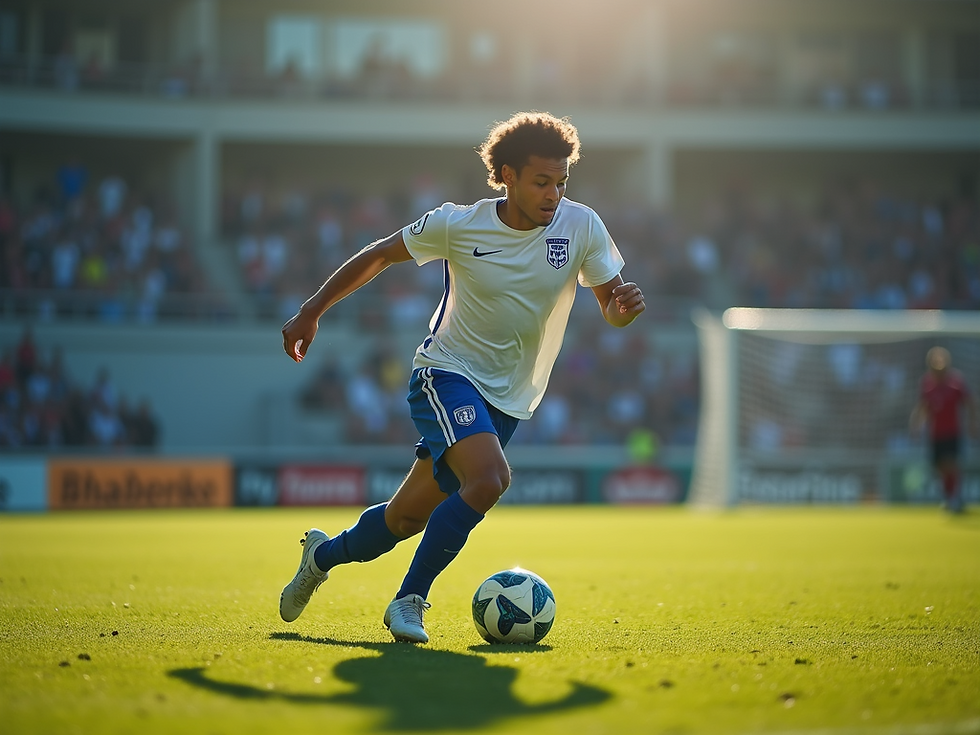Football Concentration: Essential Techniques to Improve Your Focus on the Field
- Dr Paul McCarthy

- Aug 8
- 8 min read

Introduction
In the fast-paced world of football, a player’s ability to maintain focus can make the difference between victory and defeat. Football concentration isn’t just a mental skill—it’s a fundamental aspect of performance that affects everything from decision-making to physical execution. According to recent research, athletic mental energy accounts for 66% of the variance in achieving flow state among professional football players. This statistic alone highlights why developing strong concentration skills is essential for players at all levels. Whether you’re struggling with distractions during crucial moments or looking to elevate your mental game, this guide will provide you with practical, science-backed techniques to improve your football concentration.
Why Concentration in Football Is Critical for Success
Concentration in football separates elite players from average ones. When a striker needs to finish under pressure, a defender must track multiple offensive threats, or a goalkeeper has to stay alert for 90+ minutes despite minimal action, concentration becomes the invisible skill that determines success. Effective concentration in football allows players to:
Process information quickly and make better decisions
Filter out irrelevant stimuli (crowd noise, weather conditions, trash talk)
Recover faster from mistakes
Maintain performance levels throughout the entire match
Execute skills with precision even under extreme pressure
Research shows that concentration in football can be systematically improved through specific exercises. The National Football League Players Association (NFLPA) has identified four key components of concentration that are essential for football performance: selective attention, focus maintenance, situational awareness, and attention adjustment. These components work across two dimensions: width (broad vs. narrow) and direction (external vs. internal).
Coaches emphasize that concentration in football is as important as physical skills, yet many training programs still focus predominantly on the physical aspects of the game. This creates an opportunity for players who develop their mental skills to gain a significant competitive advantage.
Understanding Attention vs Concentration in Sports: What Football Players Need to Know
Understanding the difference between attention vs concentration in sports is crucial for football players looking to improve their mental game. While these terms are often used interchangeably, they represent distinct mental processes:
Attention refers to the initial process of directing your mental focus toward specific stimuli. In football, this might mean noticing an opponent’s positioning or recognizing a tactical pattern developing on the field.
Concentration is the ability to maintain that focus over time, despite distractions or competing demands. This is what allows a player to stay engaged throughout an entire match.
Coaches often discuss attention vs concentration in sports when developing mental training programs because they require different training approaches. The relationship between attention vs concentration in sports affects how players respond during critical game moments. For example, a player might have excellent attention skills (quickly spotting an opening in the defense) but poor concentration (losing focus when a defender approaches), resulting in missed opportunities.
Football requires different types of concentration depending on the situation:
Broad-external focus: Scanning the field to assess multiple options (midfielders surveying passing options)
Narrow-external focus: Focusing on a specific target (striker concentrating on goal placement)
Broad-internal focus: Considering multiple tactical options (coach analyzing game patterns)
Narrow-internal focus: Focusing on a specific feeling or thought (player visualizing successful execution)
Learning to shift between these different types of concentration is a skill that separates good players from great ones.

Effective Football Focus Techniques for Players at All Levels
Professional teams regularly practice football focus techniques as part of their training regimen. These methods have been refined through years of sports psychology research and practical application. Learning proper football focus techniques can help players maintain performance under pressure.
1. Pre-Performance Routines
Developing a consistent pre-performance routine helps trigger concentration. This might include:
A specific warm-up sequence
Visualization of successful performance
Key phrases or cues that trigger focus
Breathing techniques to center attention
Research shows that consistent pre-performance routines help players transition into a focused state more reliably. Many elite footballers have highly personalized routines they follow before every match or important play.
2. Attentional Cues
There are several football focus techniques that can be practiced both on and off the field. One effective approach is using attentional cues—short, specific words or phrases that direct focus to the most relevant aspects of performance:
Task-relevant cues: “Watch the ball,” “Stay balanced,” “Quick feet”
Process-focused cues: “Smooth motion,” “Follow through”
Rhythm cues: Words that match the timing of movements
These cues help prevent the mind from wandering to irrelevant thoughts or worries during crucial moments.
3. Mindfulness Training
Mindfulness practices have shown significant benefits for football concentration. A meta-analysis of psychological interventions revealed that mindfulness-based approaches have a moderate positive effect (g = 0.67) on athletic performance. Regular mindfulness practice helps players:
Recognize when focus has drifted
Return attention to the present moment
Accept distractions without judgment
Maintain calm under pressure
Even 5-10 minutes of daily mindfulness practice can yield noticeable improvements in concentration abilities over time.
Top Football Concentration Drills to Enhance Your Mental Game
Incorporating football concentration drills into regular practice sessions yields significant improvements in mental focus. These football concentration drills can be adapted for players at any skill level, from youth teams to professionals.
1. Distraction Training
The most effective football concentration drills simulate real game situations with added distractions:
Practice with artificial crowd noise
Have teammates create deliberate distractions during drills
Perform skills while coach shouts unexpected commands
Execute technical skills after physical fatigue
Start with minimal distractions and gradually increase the challenge as concentration improves. This progressive approach builds mental resilience.
2. Dual-Task Training
Improve concentration by performing two tasks simultaneously:
Dribbling while solving math problems out loud
Passing accuracy drills while counting backward
Technical skills while responding to random color signals
Ball control exercises while reciting team strategies
This type of training forces the brain to manage attention more efficiently and builds the mental stamina needed during matches.
3. Focus Grid Exercises
A simple but effective concentration drill involves using a numbered grid:
Create a grid with randomly arranged numbers (1-100)
Players must find and touch/call out numbers in sequence
Add time pressure or physical movements between numbers
Incorporate ball skills for advanced versions
This exercise develops the ability to maintain focus while scanning for relevant information—a crucial skill for reading the game.
Powerful Visualization Techniques for Football Concentration
Many elite players use visualization techniques for football concentration before important matches. This mental rehearsal process helps program the mind for success and builds concentration pathways.
Mental Rehearsal
Visualization works best when it engages all senses:
Visual: See yourself performing with perfect technique
Kinesthetic: Feel the movements in your body
Auditory: Hear the sounds of the game
Emotional: Experience the feelings of success
Coaches can teach visualization techniques for football concentration to the entire team as part of pre-game preparation. The PETTLEP model (Physical, Environment, Task, Timing, Learning, Emotion, Perspective) provides a framework for effective visualization:
Physical: Visualize in the same physical state as performance
Environment: Imagine the actual venue
Task: Focus on specific skills relevant to your position
Timing: Visualize at game speed
Learning: Adjust visualizations as skills improve
Emotion: Include the emotional content of performance
Perspective: Use both internal (through your eyes) and external (watching yourself) perspectives
Regular practice of visualization techniques for football concentration improves decision-making speed and execution under pressure.
Proven Concentration Strategies for Football Players Under Pressure
When the pressure mounts during crucial game moments, having established concentration strategies becomes invaluable. These approaches help players maintain focus when it matters most:
1. Trigger Words and Reset Routines
Develop personal cue words or brief routines to quickly reset concentration after distractions:
A deep breath and specific word (“Focus” or “Now”)
A physical gesture (touching the ground, adjusting equipment)
A brief routine (three deep breaths, shake out arms)
These triggers serve as mental anchors, pulling attention back to the present moment.
2. Controlled Breathing Techniques
Breathing directly influences the nervous system and can quickly restore concentration:
Box breathing (4-count inhale, hold, exhale, hold)
Tactical breathing (4-count inhale, 4-count exhale)
Rhythmic breathing synchronized with movement
These techniques activate the parasympathetic nervous system, reducing anxiety and improving focus.
3. Concentration Narrowing
In high-pressure situations, consciously narrow your focus:
Eliminate irrelevant information
Focus only on the immediate task
Use specific visual targets
Rely on practiced responses rather than overthinking
This prevents the common problem of attention broadening under pressure, which often leads to performance errors.
The Psychology of Concentration in Sports: Football Applications
The psychology of concentration in sports reveals fascinating insights about how the mind functions under the demands of football. Understanding these principles helps players develop more effective mental training approaches.
Attentional Control Theory
This theory explains why concentration often fails under pressure. When anxiety increases, the brain’s attention system becomes more sensitive to potential threats and distractions. For footballers, this might manifest as:
Becoming overly concerned with opponents’ actions
Focusing on potential mistakes rather than execution
Increased awareness of crowd noise or coach reactions
Overthinking previously automatic movements
By understanding these natural tendencies, players can develop counter-strategies to maintain focus despite pressure.
Flow State Development
The ultimate concentration state in sports is “flow”—a state of complete absorption in the task. Research indicates that football players can increase their likelihood of achieving flow through:
Clear goals for each practice and game situation
Balance between challenge and skill level
Immediate feedback systems
Elimination of self-consciousness
Time distortion training (focusing so completely that time seems to slow down)
Players who regularly experience flow report better performance and greater enjoyment of the sport.
Developing Mental Focus in Football: A Step-by-Step Approach
Improving football concentration isn’t an overnight process—it requires systematic development. Here’s a progressive approach to building this crucial skill:
1. Assessment and Awareness
Begin by honestly assessing your current concentration abilities:
When do you lose focus during games?
What specific distractions affect you most?
How quickly can you refocus after disruptions?
Which game situations demand the most concentration?
This awareness creates the foundation for targeted improvement.
2. Basic Concentration Training
Start with fundamental exercises away from the field:
Focused breathing (maintaining attention on breath for increasing durations)
Object concentration (maintaining focus on a single object)
Body scan awareness (systematically noticing sensations throughout the body)
Guided meditation specifically designed for athletes
These exercises build the “concentration muscle” in low-pressure environments.
3. Football-Specific Integration
Gradually incorporate concentration elements into technical training:
Begin with technique drills that include minor distractions
Progress to game-like situations with increasing pressure
Practice concentration shifting between different focus types
Implement concentration challenges during team training
4. Performance Tracking and Refinement
Measure progress and continuously refine your approach:
Keep a concentration journal noting successes and challenges
Work with coaches to identify concentration lapses during games
Regularly update concentration strategies based on performance
Develop position-specific concentration protocols
This systematic approach ensures steady improvement in football concentration abilities.
Conclusion to Improve Your Focus
Football concentration represents one of the most underutilized areas for performance improvement. While physical training often takes precedence, the research clearly shows that mental skills—particularly concentration—can dramatically impact performance outcomes. By implementing the techniques, drills, and strategies outlined in this guide, players at all levels can develop stronger concentration abilities.
Remember that concentration, like any skill, improves with deliberate practice. Start with simple exercises, progress gradually, and be patient with the development process. The mental edge gained through superior concentration can be the difference between good and great performance on the football field.
Whether you’re a youth player just beginning your football journey or a seasoned professional looking to gain an edge, investing time in your concentration abilities will yield benefits that extend beyond football into all areas of life. The focus, presence, and mental discipline developed through these practices create a foundation for success both on and off the field.
Start implementing these techniques today, and watch as your football concentration—and performance—reach new heights.








